By Mary Kelley Hoppe
[su_tabs class=”my-custom-tabs”] [su_tab title=”Shark Sleuths”]
Meet the shark sleuths, a trio of preeminent researchers whose passion for sharks drew them to Florida’s Gulf Coast – Huber to the University of Tampa, Luer and Whitney to Mote Marine Laboratory in Sarasota. And it is no wonder.
Few marine research complexes in the country can rival the consortium of world-class institutions and scientists assembled here. And few places offer as ideal a laboratory as the Tampa Bay estuary, a major nursery area for sharks of all shapes and sizes.
Sharks inhabit the bay year-round, but overwhelmingly in spring and summer months when warm waters serve up copious amounts of food and provide a safe haven for baby sharks called “pups.” Tenants include hammerheads, bonnetheads, bull sharks, nurse sharks and blacktips to name a few.
Sharks have survived in our seas for over 400 million years, evolving into one of the most highly adapted animals on earth. As top predators, they play a vital role in the ecosystem, controlling populations of more abundant smaller predators that shape the very composition of marine food webs.
This issue, Bay Soundings profiles some of the people who know them best – Florida’s shark sleuths, whose ground-breaking work affirms anew the importance of protecting these epic creatures.
Fast facts about sharks
Sharks are vulnerable to fishing pressure because they:
- Grow slowly
- Take many years to reach sexual maturity (15 to 20 years in some species)
- Often reproduce only every other year
- Have few young per brood (only two pups for some species)
- Require specific nursery areas (bays and estuaries)
- Are caught in many types of fishing gear (hook and line, gillnet, trawl)
Sharks have adaptations that allow them to be apex predators including:
- Teeth that are replaced throughout their lifetime
- Sensitive smell receptors
- Eyes that adapt quickly to low light levels
- Lateral line receptors that sense movement in the water
- Electroreceptors that detect electrical fields produced by prey
Shark species common to Tampa Bay and the Gulf Coast
• Tiger • Bull • Nurse • Blacknose • Blacktip • Spinner • Lemon • Great Hammerhead • Atlantic sharpnose •
• Florida Smoothhound • Smooth dogfish • Bonnethead • Finetooth • Scalloped hammerhead •
[su_tab title=”Dr. Dan Huber”]

University of Tampa shark researcher Dan Huber
Dan Huber has stared straight into the jaws of what he calls “one of the baddest creatures that ever existed – one of the most powerful animals of all time.” Thankfully, the menacing Megalodon shark staring back was a computer simulation, part of Huber’s creation for a study on the bite force of the white shark that made Discover magazine’s list of the Top 100 stories of 2008.
Age: 30
How he got hooked?
When I was 8 years old, a relative was attacked by a shark. It flipped a switch in my head – I’ve been fascinated with sharks ever since.
Alter ego?
I’m a biologist who pretends to be a mechanical engineer.
Dan Huber is on the cutting edge of shark research. For a study on the bite force of the white shark, Huber used CT scans of a real 8-foot shark killed in a commercial fishing net to digitally reconstruct a 3-D model of the ocean predator.
The biggest challenge: “The white shark was on the other side of the planet, in Australia,” said Huber.
From the size and position of the muscles in the shark’s head, Huber and a team of Australian scientists were able to determine the force generated on each of the muscles and see what happens when they contract. “You basically apply those forces to the skeleton and run simulations that reenact what takes place during feeding.”
Assuming proportional growth within the same species, “you can zoom the model up or down to represent a much larger or smaller animal. So we did this to estimate the bite force for the largest white shark ever caught, a 21-footer.”
The results? A shark this size would be able to bite down on its prey with about 4,000 pounds of force, the equivalent of 2 tons falling on a person. Extrapolate that to the white shark’s prehistoric ancestor, the 40 to 50-foot Megalodon, and you get a bite force of 41,000 pounds, more than 20 tons.
“So, basically, you’re dealing with one of the most powerful animals of all time, one of the baddest creatures that’s ever existed.”
The research was conducted using finite element analysis, a powerful software tool widely used by engineers for understanding the mechanics of physical systems. It’s a way to evaluate and optimize a structure – a building or pipeline, for instance – before plans are finalized. “Applying it to a zoological model is pretty unique and this was the first time it had been applied to a shark,” Huber says.
“But the same principles that determine how a car will hold up in a crash – or how changing a material or shape will affect that response – are the exact same kinds of tools you can use to study biological structures, because everything has to obey the same physical principles.
“Now we can take those same ideas and apply them to skeletons. And if you compare that among different organisms at a mechanical level, you begin to get a feel for how evolution has influenced the skeleton to do different things.”
No bones about it – almost
Sharks have skeletons made of cartilage, a type of strong but flexible tissue, but it wasn’t always so. Their ancestors were bony fishes, but roughly 430 million years ago, they ditched bone in favor of cartilage.
For evolutionary biologists like Huber, that raises some basic questions: How did the shark’s cartilage skeleton evolve, how has it changed over time, and what’s the benefit of a cartilage skeleton? It turns out that a shark’s skeleton contains trace amounts of calcium mineral – just enough, according to Huber, to provide maximum advantage. “If you have a little bit of mineral and distribute it appropriately, the skeleton actually ends up being pretty effective at transmitting force.”
It’s a matter of optimization, he adds. “Just like modifying a car to be more crash resistant, animals have evolved to use minimal material that is as light and strong as possible.”
Huber’s research on these apex predators has vaulted him into the media spotlight. His bio includes consulting gigs with Discovery Channel on Shark Week and guest appearances on Evolve, a History Channel series exploring the evolution of species.
One of his primary research interests is understanding how soft-skeleton cartilaginous fish (chondrichthyans: sharks, skates, rays, and chimaeras) can eat food that is harder than they are. Take the cownose ray, for example, which dines on oysters, sea urchins and clams. It can crunch up darn near anything it can put in its mouth,” says Huber. “Mechanically, that’s really hard to do.”
Pound for pound, the cownose ray has a stronger bite than the white shark, Huber says, but the white shark’s size makes it a far more dangerous predator because it bites down with such crushing force.
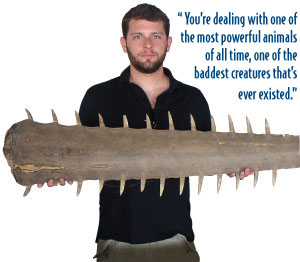
Yes, there’s a point
Beyond feeding human’s boundless fascination with sharks, there are practical applications to his research, Huber says. Bite force studies are contributing to the development of shark-resistant materials – er, sort of. “You can absolutely design something that can prevent penetration by teeth, but if there’s enough force, the shark is going to do significant damage.”
And the applications extend well beyond materials that could potentially protect divers and swimmers. Sharks wreak havoc when they burst into offshore aquaculture pens and devour fishes. They also damage naval equipment and underwater pipelines. Research is leading to the development of materials that can withstand or repel shark attacks.
Research in Tampa Bay
While Huber’s research has taken him around the globe, he conducts the same kinds of studies on sharks frequenting Tampa Bay. Using computer modeling, he’s probed the feeding biomechanics of blacktip sharks and bonnetheads, with plans for similar investigations of bull sharks and cownose rays.
It’s all in a day’s work for this master shark sleuth, who got hooked on sharks at an early age. “When I was 8 years old, a relative was attacked by a shark,” says Huber. “It flipped a switch in my head – I’ve been fascinated with sharks ever since.”
[/su_tab] [su_tab title=”Dr. Nick Whitney”]Dr. Nick Whitney, Mote Marine Laboratory
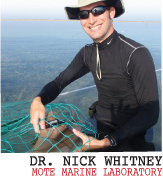
Dr. Nick Whitney
is a postdoctoral scientist who recently joined Mote Marine Laboratory’s Center for Shark Research in Sarasota. One of his specialties? Tracking the behavior and fine-scale movements of sharks.
Age: 31
Previous gig
Before joining Mote in March 2008, Whitney was a graduate student at the University of Hawaii studying whitetip reef sharks.
Why sharks?
Certainly for me, a lot of it is the mystery of it all. Sharks are difficult to measure in the wild and the fact that they are a top predator and have so many amazing adaptations that have evolved to help them survive makes them fascinating.
What do cell phones, that pricey Nintendo Wii kids are clamoring for and shark sleuth Nick Whitney have in common? They all use accelerometers, tiny instruments that detect acceleration and fine movement.
Whitney is the first to use accelerometers to study the behavior of nurse sharks. “This involves looking at the fine-scale aspects of their behavior,” he says. “So we put accelerometers on one of their fins and they record every movement the shark makes for several days at a time – tailbeat movements, body position and orientation.”
The research is being conducted in the Dry Tortugas, where Mote adjunct scientists Wes Pratt and Jeff Carrier discovered a population of nurse sharks mating over 17 years ago. Until then, they hadn’t been well-studied in the wild.
Aided by satellite tracking devices, researchers have gotten really good at figuring out where sharks go, says Whitney, “but we don’t really know what they’re doing.”
Accelerometers are giving shark researchers a new window on their world. They can reveal how fast a shark is swimming, whether it’s resting on the bottom, or oriented with its head down in the sand or reef because it’s feeding or mating.
Whitney’s focus is on the mating behavior of nurse sharks. “Accelerometers really allow us to get a full picture of what we’ve only been able to get glimpses of over the years,” he says.
“We’re interested in questions like when they mate, what time of day or night and mating patterns – which leads to other questions like whether a female chooses her partners or does she simply get fed up with being chased and submit to avoid harassment.”
Studies have shown that 92% of the time the male grabs a female he’s not actually successful in mating. “That suggests that females seem to have some element of control or choice, but we don’t know that for certain. These are just some of the wide variety of questions we’re trying to address at least partially through accelerometry.”
Grasp, thrash and roll
Mating begins when a male shark grasps a female’s pectoral fin. “There’s usually a lot of rolling and thrashing that goes on, and headstands where their heads are literally resting on the bottom and their tails will be pointing up to the sky,” explains Whitney. Then there are periods of no movement whatsoever. “It’s almost like the male is trying to catch his breath before the next big attempt.”
Because accelerometers can capture both movement and body posture, the sharks’ rolls provide a very clear signature of mating in the data recordings.
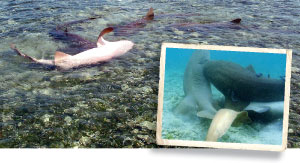
Photos courtesy of Mote Marine Laboratory
Above, left: Nurse sharks roll in the shallow waters off the Dry Tortugas in preparation for mating. Inset: Mating begins when a male shark grasps a female’s pectoral fin. Accelerometers, tiny motion-sensing microchips embedded in pinger tags, record their movements.
It appears that female nurse sharks can be much more selective in shallow water because it’s easier for them to avoid mating. “But the question is, are they using shallow water to avoid males altogether or as a tool to be much more selective about which males they mate with.
“It may be that she’s using the shallow water to wait for the right guy,” says Whitney.
One surprising finding from the research is that the nurse sharks are mating almost exclusively during the day, which is interesting because sharks are thought to be more active at night. Why is not yet clear. “For whatever reason, it may be that it’s simply more advantageous for the sharks to mate during the day or it may be that we only have data from six animals so far – a fluke that will work itself out as we get data from more animals.” Nevertheless, says Whitney, it’s a surprisingly strong signal. Out of 26 logged mating events, 24 have occurred during daylight hours.
Whitney says the findings are likely applicable to nurse sharks closer to home. “Just this summer there were reports of nurse sharks mating in very shallow waters in Terra Ceia Bay, and it sounded very similar to the kinds of behaviors we’re seeing here in the Tortugas.”
About accelerometers
Accelerometers have become a huge part of new technology, from video games – think Wii – to cell phones and digital cameras. The motion-sensing microchips found in these hand-held instruments record movements – how fast you’re moving a joystick, for example, and in what direction, which way a camera is oriented and when you tilt your cell phone, prompting it to reorient the picture on the screen. They’re also being used in human studies to measure sleep patterns and the relationship between watching TV and childhood obesity.
Capturing data
The accelerometers – essentially thumbnail-sized microchips – are embedded with time-release pinger tags that record data. The tags are designed to corrode in sea water and fall off after a few days. “Because the nurse sharks in Tortugas tend to stay in a fairly small area, instead of having the tags float up, we let them sink to the bottom and transmit an acoustic signal we pick up through an underwater hydrophone,” Whitney says. “We then retrieve the tag to get the data or, whenever possible, we’ll recapture the animal.”
So far, the research team has outfitted well over a hundred nurse sharks with basic ID tags, but only six are carrying accelerometers. “But with each of those six, we have multiple days of data – so for 2 to 4 days we’ll know literally every move thatanimal made every second of the day, which is unprecedented.”
The researchers also hope to use accelerometers to study bull sharks and other species in the wild around Mote, once logistical hurdles are worked out. Right now, the tags being used record so much data – 15 separate data points per second – that it’s too much to transmit either through acoustic transmitters or satellite tags.
“Basically, we have to store all the data to memory on the tag itself, so the real logistical hurdle is retrieving the tag from the animal. That will entail designing tag packages that attach securely enough to the fin to record accurate body movements, but still release and float to the surface to transmit a radio signal allowing us to find and recover the tag. There’s nothing like that on the market right now so we have to design our own.”
Next up?
Whitney wants to expand the research to male nurse sharks, adding devices that will give them depth measurements and accelerometers that can be deployed for longer time periods.
“The first phase has shown us that we can identify mating events based on accelerometer data. The next step is to look at the fine-scale behaviors of what the sharks are doing every second and find out how much time they spend resting versus swimming, for example.” A depth sensor already added to one nurse shark revealed something no one expected. “We found that one nurse shark went offshore and dove to a hundred feet, rested on the bottom for a few minutes, and did this repeatedly for about a day. No one has ever seen that kind of repetitive diving behavior. We’ve always just assumed that they remained in the shallows – whereas, at least for one animal so far, we saw that she went offshore to do these deep dives and then came back to the shallows and mated.
“Anytime you have technology like this it opens up a whole new world, and you often have the case where it raises more questions than it answers.”
Whitney says the next generation of data tags will be able to record data for several weeks, and in the foreseeable future, a couple of months. “We can get information on how often these sharks mate over a season, how much energy they’re using, so within the next 10 years or so we could know what the energy expenditure of a shark is over a year. That gets into some really interesting questions like how many fish they need to eat over a day to sustain that energy.”
Mote also plans to use accelerometers to study captive species at their lab in Sarasota and whale sharks in Mexico. “With whale sharks, they’re such a unique species, that the questions are wide open,” says Whitney. “Even observing them at the surface, we see them do all kinds of strange things and body movements we can’t really explain – and we suspect that we’re really seeing just the tip of the iceberg.
“We know they do a lot of deep diving, but we have no idea why, so we’re really excited to get some data from those guys to find out what they’re doing when they’re going down deep.”
Why research is important
“We know almost nothing about mating behavior in most shark species – we rarely see it because it’s hard to observe natural shark behavior.” In the shallow waters in the Tortugas, “we can put these devices on nurse sharks and actually see them mating, essentially ground-truthing our data with direct observations.”
Whitney views this as the first step toward a broader goal of quantifying mating behavior in shark species for which it cannot be directly observed.
Accelerometers also can provide important clues to shark behavior in general, he says. “That hasn’t really been done other than looking at their broad horizontal and vertical movements, which don’t tell us what they’re actually doing or why.”
[/su_tab]
[su_tab title=”Dr. Carl Luer”]
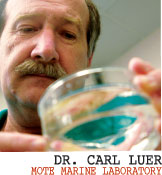
Dr. Carl Luer
joined Mote Marine Laboratory in 1979 to develop a marine biomedical program. His current research focuses on the biochemistry and immunology of elasmobranch fishes as it relates to their relatively low incidence of cancer and infectious disease. Luer is past president of the American Elasmobranch Society, an international society dedicated to the scientific study of sharks, skates and rays.
Age: 61
Hero:
Linus Pauling – chemist, peace activist and educator, the only individual to have been awarded two unshared Nobel prizes, the 1954 Nobel Prize in Chemistry and the Nobel Peace Prize in 1962. “I met him at the University of Kansas and he had a profound effect on me.”
Thirty years ago, Luer set out to explore the low incidence of cancer in sharks. He spent 10 years using carcinogens to induce cancer in sharks and skates, to no avail. Then Luer and a former Mote colleague, Cathy Walsh, turned their attention to shark immunology. Their investigations confirmed that sharks have a unique organ not present in other animals that does nothing but produce immune cells.
Eventually, Luer and Walsh found that these unusual cells could, in the lab, secrete a substance that inhibits human cancer cells. So far, they have tested the substance on 15 cell lines originating from human tumors, including breast, pancreatic and prostate cancer. And it has inhibited cancer in all of them, to varying degrees.
Now Luer, who has obtained two patents for his lab methods, is seeking additional funding to move forward. He hopes to someday be able to understand and isolate sharks’ tumor-inhibiting substance so it can be synthesized to fight human cancer.
“We want to understand what mechanism they’re using to inhibit the tumor cells because that’s important in leading to the drug discovery,” Luer says. “Obviously, you want a drug that specifically targets cancer cells. One of the biggest problems with radiation and chemotherapy is that a lot of healthy cells get zapped in the process.”
Preliminary data suggests that the tumor-inhibiting substance sharks produce selectively targets cancer cells and not normal cells.
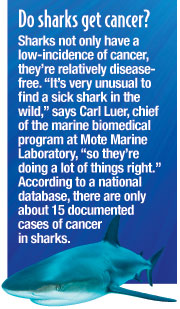
Uncovering sharks’ secret cancer-fighting agent
So what’s the difference in the shark immune system that makes them less prone to cancer? “That’s the $64-million-dollar question,” says Luer. “What we do know is that there are basic similarities and some stark differences between the immune systems of sharks and other vertebrates.” Sharks, skates and rays are among the earliest representatives of vertebrate animals still around on earth that have an ‘adaptive immune system’ – one that adjusts to foreign substances and then remembers them and responds more positively the next time they are exposed. “And that’s the basis upon which vaccines are made,” explains Luer. In humans, most disease-fighting immune cells are produced in the bone marrow. But sharks don’t have a skeleton made of bone – ergo, no bone marrow.
Instead, Luer and Walsh discovered an organ unique to sharks that exists solely to produce immune cells. The epigonal organ, so-called because of its proximity to the gonad, acts as a kind of bone marrow equivalent. “We think it’s important in keeping these animals relatively disease free, and we’ve learned a lot in the last few years about how to put these immune cells into short-term culture in the laboratory.”
When shark immune cells are grown in a flask, they will secrete proteins into the surrounding medium. But the conditions needed to successfully culture them are quite different from those conducive to human cell growth.
Using dialysis, Luer removes the proteins and places them in an environment conducive to mammalian cell growth. “In that form, we can incubate those proteins with human tumor cell lines in the lab and observe what happens.”
While Luer never approaches any experiment trying to force results, he says he was surprised that whatever the cells were secreting was so effective in inhibiting human tumor cells.
Because the parent proteins are large, one of the challenges has been breaking them down into smaller components, called peptides, while retaining their ability to inhibit tumors. “The smaller the molecule, the easier it is to develop into a therapeutic drug.”
That requires isolating the peptides that target tumor cells, sequencing them to determine their structure, and then synthesizing them in amounts sufficient for animal studies. At that point, pharmaceutical companies may become interested.
Luer says that they won’t be relying on natural shark populations as a source for product development. “We want to be able to understand the structure and make it artificially.”
The goal is to isolate the peptides that inhibit tumors in humans. “We think there’s the potential for some novel molecules that are not available at this point to be used as cancer drugs, but it’s all based on funding.”
[/su_tab]
[/su_tabs]
Article originally published 2010.
[su_divider]